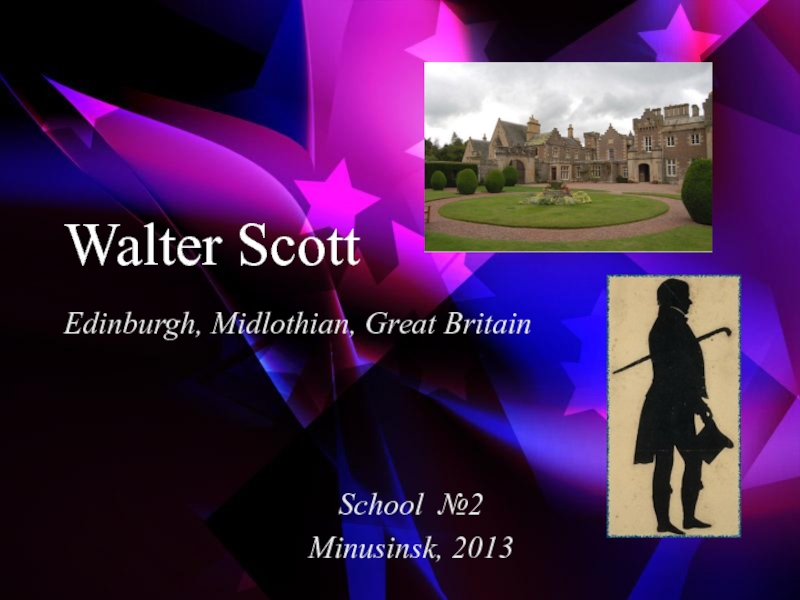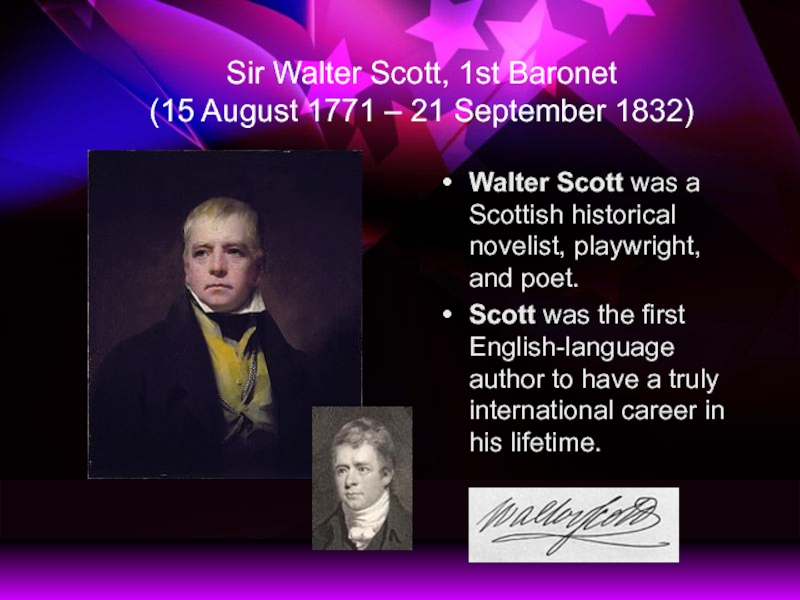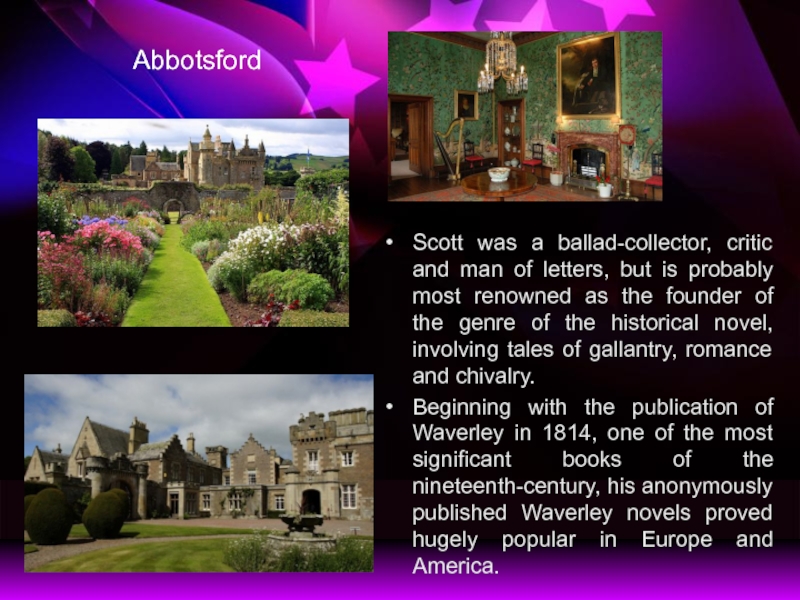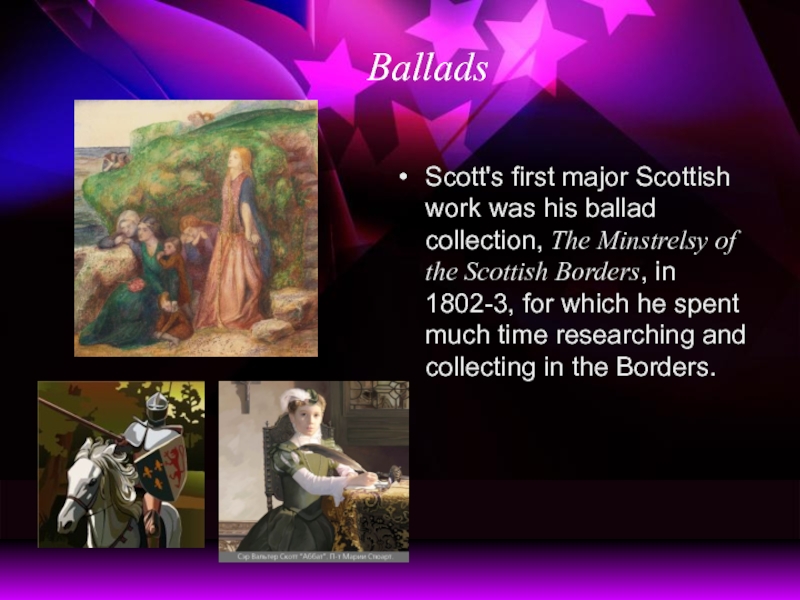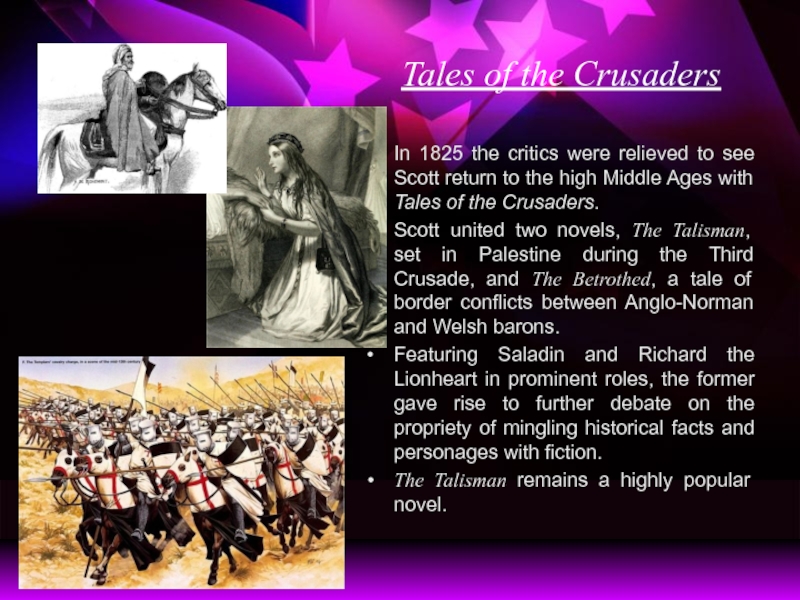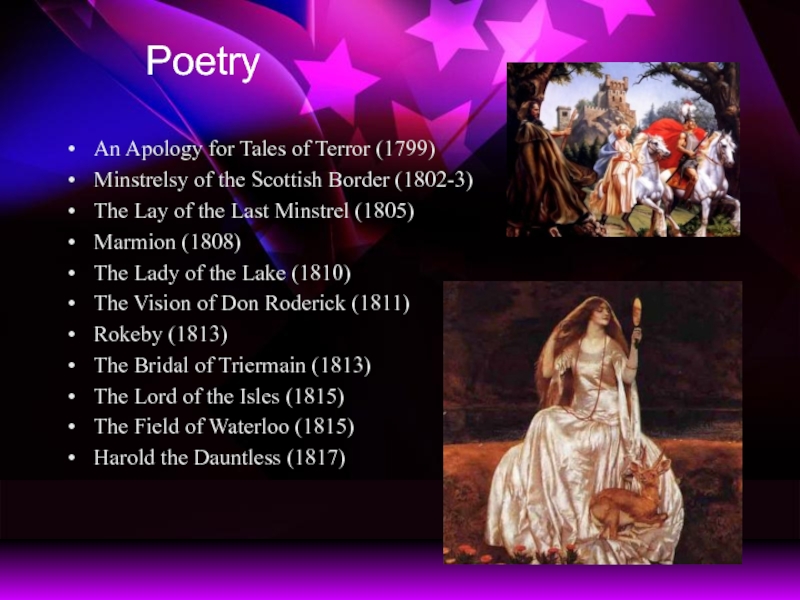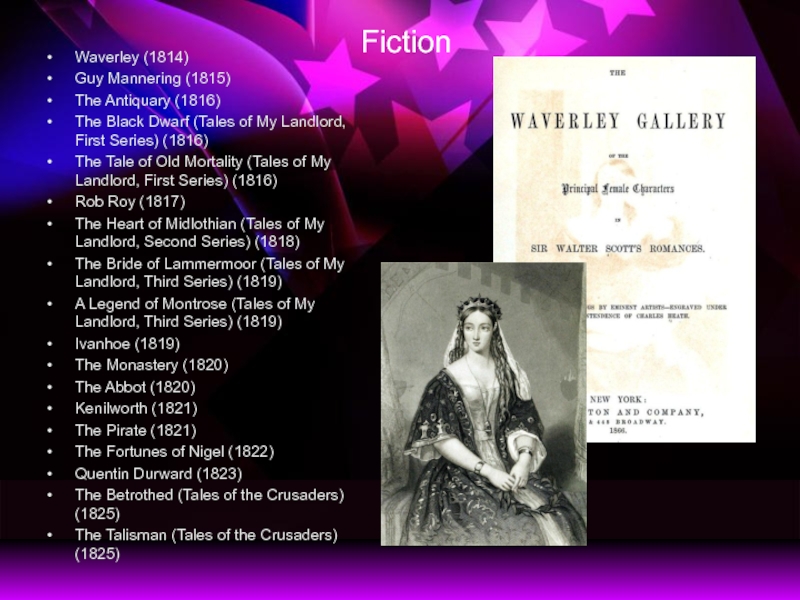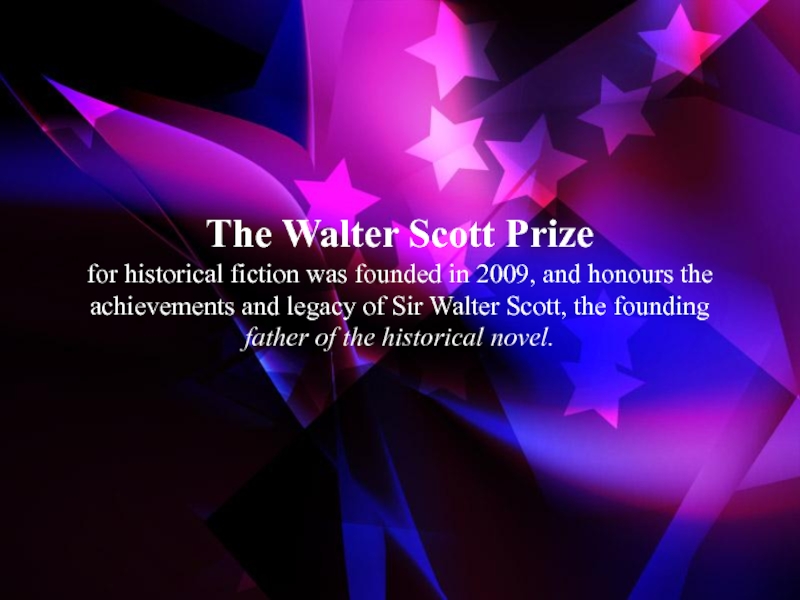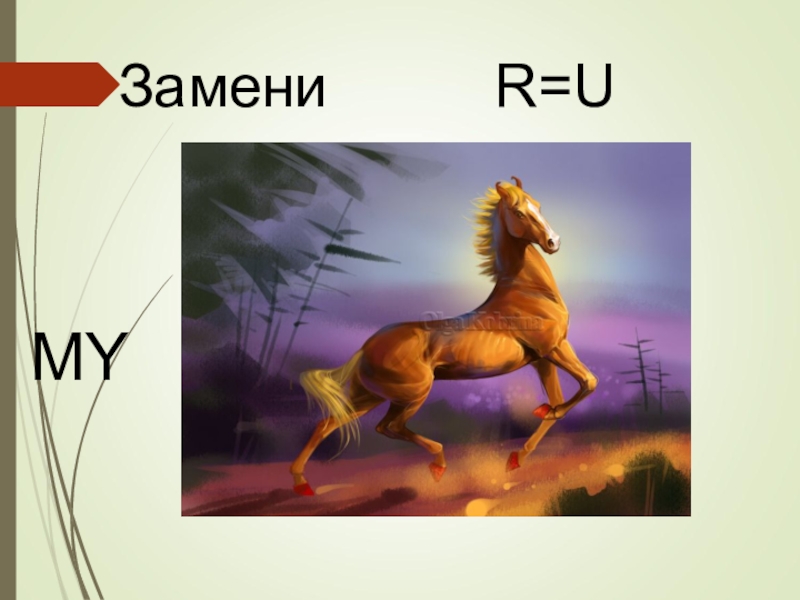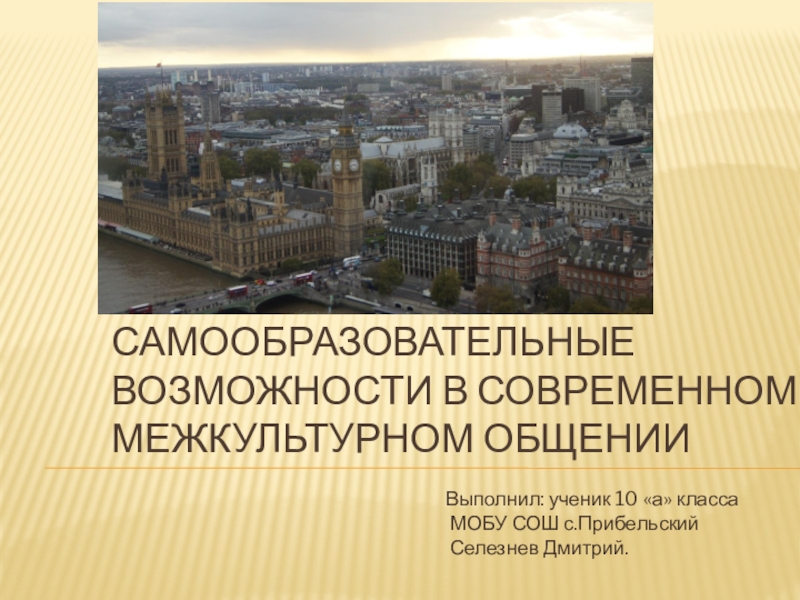- Главная
- Разное
- Образование
- Спорт
- Естествознание
- Природоведение
- Религиоведение
- Французский язык
- Черчение
- Английский язык
- Астрономия
- Алгебра
- Биология
- География
- Геометрия
- Детские презентации
- Информатика
- История
- Литература
- Математика
- Музыка
- МХК
- Немецкий язык
- ОБЖ
- Обществознание
- Окружающий мир
- Педагогика
- Русский язык
- Технология
- Физика
- Философия
- Химия
- Шаблоны, фоны, картинки для презентаций
- Экология
- Экономика
Презентация, доклад по английскому языку Вальтер Скотт
Содержание
- 1. Презентация по английскому языку Вальтер Скотт
- 2. Sir Walter Scott, 1st Baronet (15 August
- 3. AbbotsfordScott was a ballad-collector, critic and man
- 4. BalladsScott's first major Scottish work was his
- 5. Scott's novels of the next period are
- 6. “Ivanhoe”Scott's next novel marked his first fictional
- 7. Quentin DurwardTwo further novels appeared in 1823.
- 8. Tales of the CrusadersIn 1825 the critics
- 9. Poetry An Apology for Tales of Terror
- 10. FictionWaverley (1814)Guy Mannering (1815)The Antiquary (1816)The Black
- 11. The Walter Scott Prize for historical
Sir Walter Scott, 1st Baronet (15 August 1771 – 21 September 1832)Walter Scott was a Scottish historical novelist, playwright, and poet. Scott was the first English-language author to have a truly international career in his lifetime.
Слайд 2Sir Walter Scott, 1st Baronet
(15 August 1771 – 21 September 1832)
Walter
Scott was a Scottish historical novelist, playwright, and poet.
Scott was the first English-language author to have a truly international career in his lifetime.
Scott was the first English-language author to have a truly international career in his lifetime.
Слайд 3Abbotsford
Scott was a ballad-collector, critic and man of letters, but is
probably most renowned as the founder of the genre of the historical novel, involving tales of gallantry, romance and chivalry.
Beginning with the publication of Waverley in 1814, one of the most significant books of the nineteenth-century, his anonymously published Waverley novels proved hugely popular in Europe and America.
Beginning with the publication of Waverley in 1814, one of the most significant books of the nineteenth-century, his anonymously published Waverley novels proved hugely popular in Europe and America.
Слайд 4Ballads
Scott's first major Scottish work was his ballad collection, The Minstrelsy
of the Scottish Borders, in 1802-3, for which he spent much time researching and collecting in the Borders.
Слайд 5Scott's novels of the next period are devoted to English subjects,
covering
the days after the Norman Conquest ("Ivanhoe",1820),
the life during the Tudor dynasty (" Kenilworth", 1821)
the Stuart rule ("The Fortunes of Nigel", l822).
the English Revolution("Woodstock",1826)
the Restoration period ("Peveril of the Peak" . 1828).
Of this group the best known is "Ivanhoe".
the days after the Norman Conquest ("Ivanhoe",1820),
the life during the Tudor dynasty (" Kenilworth", 1821)
the Stuart rule ("The Fortunes of Nigel", l822).
the English Revolution("Woodstock",1826)
the Restoration period ("Peveril of the Peak" . 1828).
Of this group the best known is "Ivanhoe".
Слайд 6“Ivanhoe”
Scott's next novel marked his first fictional excursion outside the bounds
of Scotland.
Ivanhoe (1820), set in twelfth-century England, was published under a new pseudonym Laurence Templeton. The novel rapidly became an international phenomenon, launching Scott's continental vogue and providing the blueprint for the historical novel across Europe.
In Britain, it played a major role in sparking the nineteenth-century fascination for all things medieval.
Ivanhoe (1820), set in twelfth-century England, was published under a new pseudonym Laurence Templeton. The novel rapidly became an international phenomenon, launching Scott's continental vogue and providing the blueprint for the historical novel across Europe.
In Britain, it played a major role in sparking the nineteenth-century fascination for all things medieval.
Слайд 7Quentin Durward
Two further novels appeared in 1823. Quentin Durward, set in
fifteenth-century France.
In stark contrast, Quentin Durward caused a similar sensation in France to Waverley in Scotland and Ivanhoe in England. The vogue for the novel spread across Europe, awakening renewed interest in Britain.
In stark contrast, Quentin Durward caused a similar sensation in France to Waverley in Scotland and Ivanhoe in England. The vogue for the novel spread across Europe, awakening renewed interest in Britain.
Слайд 8Tales of the Crusaders
In 1825 the critics were relieved to see
Scott return to the high Middle Ages with Tales of the Crusaders.
Scott united two novels, The Talisman, set in Palestine during the Third Crusade, and The Betrothed, a tale of border conflicts between Anglo-Norman and Welsh barons.
Featuring Saladin and Richard the Lionheart in prominent roles, the former gave rise to further debate on the propriety of mingling historical facts and personages with fiction.
The Talisman remains a highly popular novel.
Scott united two novels, The Talisman, set in Palestine during the Third Crusade, and The Betrothed, a tale of border conflicts between Anglo-Norman and Welsh barons.
Featuring Saladin and Richard the Lionheart in prominent roles, the former gave rise to further debate on the propriety of mingling historical facts and personages with fiction.
The Talisman remains a highly popular novel.
Слайд 9Poetry
An Apology for Tales of Terror (1799)
Minstrelsy of the Scottish Border
(1802-3)
The Lay of the Last Minstrel (1805)
Marmion (1808)
The Lady of the Lake (1810)
The Vision of Don Roderick (1811)
Rokeby (1813)
The Bridal of Triermain (1813)
The Lord of the Isles (1815)
The Field of Waterloo (1815)
Harold the Dauntless (1817)
The Lay of the Last Minstrel (1805)
Marmion (1808)
The Lady of the Lake (1810)
The Vision of Don Roderick (1811)
Rokeby (1813)
The Bridal of Triermain (1813)
The Lord of the Isles (1815)
The Field of Waterloo (1815)
Harold the Dauntless (1817)
Слайд 10Fiction
Waverley (1814)
Guy Mannering (1815)
The Antiquary (1816)
The Black Dwarf (Tales of My
Landlord, First Series) (1816)
The Tale of Old Mortality (Tales of My Landlord, First Series) (1816)
Rob Roy (1817)
The Heart of Midlothian (Tales of My Landlord, Second Series) (1818)
The Bride of Lammermoor (Tales of My Landlord, Third Series) (1819)
A Legend of Montrose (Tales of My Landlord, Third Series) (1819)
Ivanhoe (1819)
The Monastery (1820)
The Abbot (1820)
Kenilworth (1821)
The Pirate (1821)
The Fortunes of Nigel (1822)
Quentin Durward (1823)
The Betrothed (Tales of the Crusaders) (1825)
The Talisman (Tales of the Crusaders) (1825)
The Tale of Old Mortality (Tales of My Landlord, First Series) (1816)
Rob Roy (1817)
The Heart of Midlothian (Tales of My Landlord, Second Series) (1818)
The Bride of Lammermoor (Tales of My Landlord, Third Series) (1819)
A Legend of Montrose (Tales of My Landlord, Third Series) (1819)
Ivanhoe (1819)
The Monastery (1820)
The Abbot (1820)
Kenilworth (1821)
The Pirate (1821)
The Fortunes of Nigel (1822)
Quentin Durward (1823)
The Betrothed (Tales of the Crusaders) (1825)
The Talisman (Tales of the Crusaders) (1825)
Слайд 11The Walter Scott Prize for historical fiction was founded in 2009,
and honours the achievements and legacy of Sir Walter Scott, the founding father of the historical novel.
